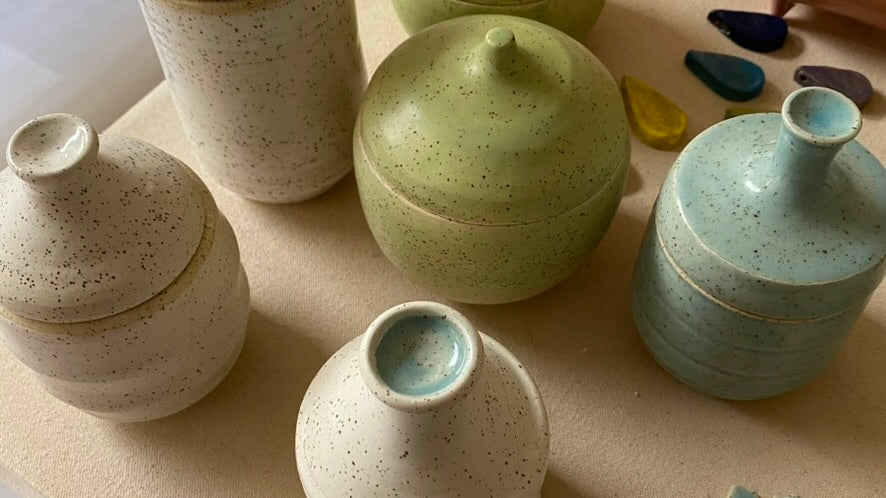This year I made a lot of forms that were new to me! Previously, I had a good amount of practice with throwing basic cylinders and turning them into cups and bowls. I had also pulled and attached a handle to make mugs, or punched a drainage hole to make planters, or done some light shaping to form bud vases.
This year I added yarn bowls, colanders, narrow-neck vases, planters with attached drip trays, closed form containers, hanging wall art, and ring dishes to my repertoire. Here's a little insight into what makes each of these forms an interesting challenge for a potter.
yarn bowls

Throwing a yarn bowl starts off like throwing any other bowl... until you need to cut a channel for the yarn. This is a huge cut that can affect the structural integrity of the piece—which needs to be dry enough that it holds its shape, but not so dry that it cracks easily. It was scary to saw through the clay and see it wiggle. One tip I discovered is to leave the carved portion in place until finished cutting, so that the surrounding clay can still lean on it. I might need to buy a sharper scalpel if I make more.
berry bowls

This is my absolute favorite piece I made this year, and I kept it for myself. The form is pierced all over, and each new hole can make the piece more fragile. It also required pulling matching handles to sit opposite each other, and after trimming the foot I altered it to have a few channels for water to flow out underneath.
narrow-neck vases

Narrow necks take patience. It is a slow process of collaring the wall inward, and pulling the clay upward, in alternation over several passes. You also have to be careful not to drip water inside the form, once the opening becomes too narrow for you to sponge it out.
planters with attached drip tray

To create this form you first portion out some clay at the base of the pot to become the drip tray, flattening it onto the wheelhead and out of the way. Then with the bulk of the clay you throw the center cylinder. Finally, return to the saved clay and coax its edges up to finish the tray. Once leather hard, add a few drainage holes to the inner pot.
closed form lidded containers

wall art with beads

This wall canvas was a rare pure hand-building project, worked with rolled slabs of clay attached at beveled joins. On the backside of the canvas are hidden crossbeam supports to ensure the large flat front wouldn't slump during glaze firing, and loops for stringing a hanging wire through. Working with wire and crimping beads was new for me as well. This piece now hangs in my entryway, and I love it.
ring dishes

Last but not least, I made ring dishes, another double-walled form similar to the planters above, except that you throw a narrow inner cylinder like the vase, and cinch it closed like the lidded jars. I once bought a ring that holds a powerful story for me, that I'll tell you later this year!

